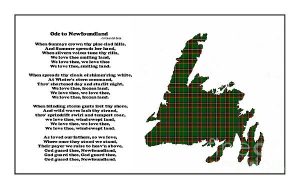ARCHIVAL MOMENT
August 17, 1979
 On August 17, 1979, Royal Assent was given to legislation adopting the Ode to Newfoundland as the official provincial anthem of the province of Newfoundland.
On August 17, 1979, Royal Assent was given to legislation adopting the Ode to Newfoundland as the official provincial anthem of the province of Newfoundland.
The song the “Newfoundland” now known as the “Ode To Newfoundland” was sung for the very first time on January 21, 1902 at the Casino Theatre in St. John’s. The local St. John’s newspaper, The Daily News, reported that the new song was greeted enthusiastically.
The newspaper article reads:
“Miss Frances Daisy Foster rendered with exquisite feeling a new song entitled “Newfoundland.” It proved a pleasant surprise and the general appreciation of it was marked by the audience joining spontaneously in the chorus.”
The “Ode to Newfoundland” was composed by Governor, Sir Cavendish Boyle, the original score was set to the music of E.R. Krippner, a German bandmaster living in St. John’s but Boyle desired a more dignified score. It was then set to the music of British composer Sir Hubert Parry, a personal friend of Boyle, who composed two settings.
The Daily News reporter knew that he had heard something special when he heard the ‘Newfoundland’ being sung for the first time , he wrote: “he (Boyle) has given us a poem which may be chosen as the Colony’s own anthem.”
On June 21,1902 it was “resolved by the Committee of Council that the Ode “Newfoundland”, written by His Excellency Sir Cavendish Boyle, K.C.M.G., Governor of Newfoundland, with the musical setting by Professor E.R. Krippner, be approved, and officially recognized as the Colonial Anthem.”
That should have been it, all was required was the signature of the Governor. The Governor however refused to sign. Arthur Mews, The Deputy Colonial Secretary of the day wrote:
“His Excellency (Governor Boyle) from motives of delicacy, did not formally approve the same at that time.”
The “delicacy’ was that Governor Boyle was both author of the Ode and Governor, it simply did not look proper that he sign off on his own Ode.
The Premier of the day, Sir Robert Bond, determined that the Ode become the official anthem suggested that given the hesitation of Governor Boyle that approval be given by the Hon. W.H. Horwood, C.J. , Administrator of the Government. But it was not to happen.
By 1904, the ‘Newfoundland’ had become firmly established, in the minds of most people, as the “official anthem” of the Dominion of Newfoundland, there was no Government function without the ‘Newfoundland’, it was sung at most public gatherings, in parish halls and concert halls. It was so firmly established that in the 1909 General Election, Robert Bond proposed that if elected he would be certain to make it the “official” anthem of the country.
Bond lost the election.
Nothing was said of the official status of the Ode until 1972. Frank Graham in his book “We Love Thee Newfoundland” Biography of Sir Cavendish Boyle, wrote:
“At an event in St. John’s it was observed that a certain military group failed to observe protocol and the proprieties by coming to attention and showing the proper respect during the playing of Newfoundland’s anthem. The commanding officer was called on the carpet to explain the unseemly conduct of his men. The officer defended himself and his group by explaining that there was noting on the statue books to confirm the fact that the Ode was Newfoundland’s Provincial anthem. It transpired that he was right.”
In 1974 their was a resurgence of interest in making the Ode official, (driven by Lieutenant Governor, Gordon A. Winter,) that resulted in the introduction of the Provincial Anthem Act for the Province of Newfoundland. On May 2, 1975 the legislation became official. It reads:
“The poem commonly called the Ode to Newfoundland, composed by Sir Cavendish Boyle, Governor of Newfoundland from 1901 -1904, as it appears in the schedule is adopted as the provincial anthem of the Province of Newfoundland and shall be officially known and recognized as the Ode to Newfoundland.”
The Ode to Newfoundland
When sun rays crown thy pine clad hills,
And summer spreads her hand,
When silvern voices tune thy rills,
We love thee, smiling land.Refrain
We love thee, we love thee,
We love thee, smiling land.When spreads thy cloak of shimmering white
at winter’s stern command
Through shortened days and
starlit nights we love thee frozen land
We love thee, we love thee, we love thee frozen land.
Refrain
We love thee, we love thee,
We love thee, frozen land.When blinding storm gusts fret thy shores
and wild waves wash their strands,
Through spindrift swirls and tempest roars
we love thee windswept land,
We love thee, we love thee, we love thee
windswept land.
Refrain
We love thee, we love thee,
We love thee, windswept land.As loved our fathers, so we love,
Where once they stood, we stand;
Their prayer we raise to Heaven above,
God guard thee, NewfoundlandRefrain
God guard thee, God guard thee,
God guard thee, Newfoundland
Recommended Archival Collection: Take some time to look at MG 956.110 at the Rooms; this cover illustration featuring the Ode to Newfoundland depicts some of the iconic symbols and images of Newfoundland and Labrador. https://www.therooms.ca/collections-research/our-collections
Recommended Book: “We Love Thee Newfoundland” Biography of Sir Cavendish Boyle, K.C.M.G. Governor of Newfoundland 1901 -1904 by Frank W. Graham. Creative Printers, St. John’s, 1979.
Recommended Reading: Geoff Butler, Ode to Newfoundland. Lyrics by Sir Cavendish Boyle. Toronto: Tundra Books, 2003.




